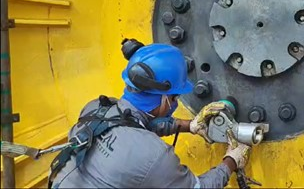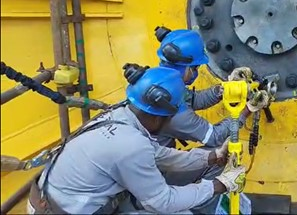Previously, torqueing was performed manually or with tools that lacked adequate safety mechanisms. In this process, the worker would position their upper limbs and body in critical areas, i.e., in the “line of fire.”
The worker was exposed to risk during the torqueing operation and had to adopt improper postures, such as bending or positioning their arms and hands close to pressure points or moving elements.
Additionally, the process was time-consuming, requiring more physical effort and extending the time needed to complete tasks. Furthermore, the quality of the service was compromised, as the torque precision was variable, with frequent adjustment errors, which impacted assembly efficiency and the equipment’s durability.
These combined factors created a work environment with a higher likelihood of accidents, low efficiency and operational inconsistencies, justifying the need for a safer and more efficient solution.
Goals
Increase worker safety, productivity, and task quality.
Actions
E2E methodology to define and develop the problem and test the solution.
Objectives
Create a device to assist in the task, reducing physical strain on employees, minimizing limb exposure to risk, improving ergonomics and enhancing torqueing quality.
Timeline
7 days to complete the project, develop the device, validate with mechanics and safety teams and begin supervised testing.
Waste Addressed
Defects/rework, unnecessary movement, excessive processing.
Procedure Before the Solution
Torqueing was performed manually or with tools lacking proper safety mechanisms. Risks of crushing, cuts, or impacts from misaligned tools or components; improper posture, fatigue due to excessive effort; low productivity and quality.
Check out some photos below
Procedure with the implemented solution
Elimination of worker exposure to the “line of fire,” preventing crush injuries, cuts, and impacts. Improved ergonomics with reduced repetitive movements, fatigue, and operational errors. Less physical effort, higher productivity and increased quality due to more precise torqueing, ensuring greater equipment durability.
Check out some photos below
Results
- HSE & Risk: Zero incidents recorded during the activity, eliminating worker exposure to the “line of fire” and preventing crush injuries, cuts, and impacts.
- Productivity & Costs: Approximately 90% reduction in activity time.
- Quality: Elimination of post-adjustments (rework) and improved equipment durability.
- People: Increased safety and team motivation.



